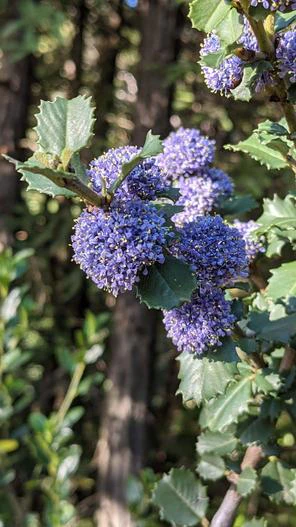Point Reyes Ceanothus
(Ceanothus gloriosus var. exaltatus)
Point Reyes Ceanothus (Ceanothus gloriosus var. exaltatus)
/
/

Chloe and Trevor Van Loon
CC BY 4.0
Image By:
Chloe and Trevor Van Loon
Recorded By:
Copyright:
CC BY 4.0
Copyright Notice:
Photo by: Chloe and Trevor Van Loon | License Type: CC BY 4.0 | License URL: http://creativecommons.org/licenses/by/4.0/ | Occurence ID: https://www.gbif.org/occurrence/3994321366 | Publisher: Inaturalist |



















Estimated Native Range
Climate Requirements for Sanger, California
| This Plant | Your Site | Plant Suitability for Your Location | ||
|---|---|---|---|---|
| • Precipitation | 24" - 77" | 13" | Your precipitation may be insufficient for this plant. Irrigate N" / year. | Irrigate N" / year |
| • High Temp. | 68°F - 87°F | 98°F | Your summers may be too hot for this plant. | Too hot |
| • Low Temp. | 33°F - 42°F | 36°F | Your winter temperatures are normal for this plant | Excellent |
This plant should grow well at your location with about N inches per year (Y minutes per month) of irrigation.
Summary
Ceanothus gloriosus var. exaltatus, commonly known as Point Reyes Ceanothus, is an evergreen shrub native to coastal scrub and chaparral habitats of California, particularly in the Point Reyes area. It typically grows to a height of 2-4 feet (0.6-1.2 meters) and spreads 8-10 feet (2.4-3 meters) wide. This species forms a dense mound with glossy, dark green leaves and rigid branches. The flowers, which are quite showy, range in color from deep blue to purple and bloom profusely in the spring, with some varieties also blooming in winter.
Point Reyes Ceanothus is valued for its drought tolerance and ability to thrive in poor, rocky soils, making it an excellent choice for xeriscaping and native plant gardens. It is also used for slope stabilization and as a ground cover due to its extensive root system. In cultivation, it requires minimal maintenance once established, needing only occasional pruning to maintain shape. It prefers full sun but can tolerate light shade and requires well-drained soils. Overwatering should be avoided to prevent root rot. While generally disease-resistant, it can be susceptible to fungal diseases in humid conditions. No popular garden cultivars are noted, and there is no significant concern regarding invasiveness when grown outside its native range.CC BY-SA 4.0
Point Reyes Ceanothus is valued for its drought tolerance and ability to thrive in poor, rocky soils, making it an excellent choice for xeriscaping and native plant gardens. It is also used for slope stabilization and as a ground cover due to its extensive root system. In cultivation, it requires minimal maintenance once established, needing only occasional pruning to maintain shape. It prefers full sun but can tolerate light shade and requires well-drained soils. Overwatering should be avoided to prevent root rot. While generally disease-resistant, it can be susceptible to fungal diseases in humid conditions. No popular garden cultivars are noted, and there is no significant concern regarding invasiveness when grown outside its native range.CC BY-SA 4.0
Plant Description
- Plant Type: Subshrub, Shrub
- Height: 2-4 feet
- Width: 8-10 feet
- Growth Rate: Moderate
- Flower Color: Blue, Purple
- Flowering Season: Spring, Winter
- Leaf Retention: Evergreen
Growth Requirements
- Sun: Full Sun
- Water: Low
- Drainage: Medium, Fast
Common Uses
Bee Garden, Bird Garden, Butterfly Garden, Drought Tolerant, Groundcover, Hummingbird Garden, Low Maintenance, Showy Flowers
Natural Habitat
Coastal scrub and chaparral habitats of California, particularly in the Point Reyes area
Other Names
Common Names: Glory Bush
Scientific Names: Ceanothus gloriosus var. exaltatus, Ceanothus gloriosus subsp. exaltatus, Ceanothus exaltatus
GBIF Accepted Name: Ceanothus gloriosus var. exaltatus J.T.Howell